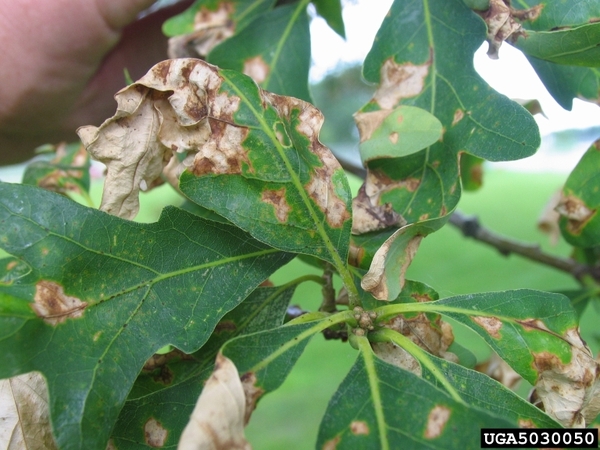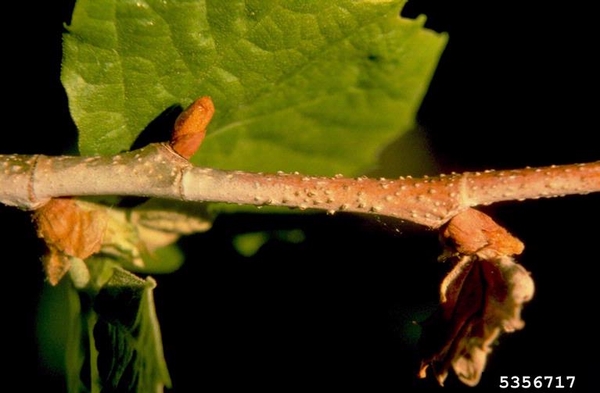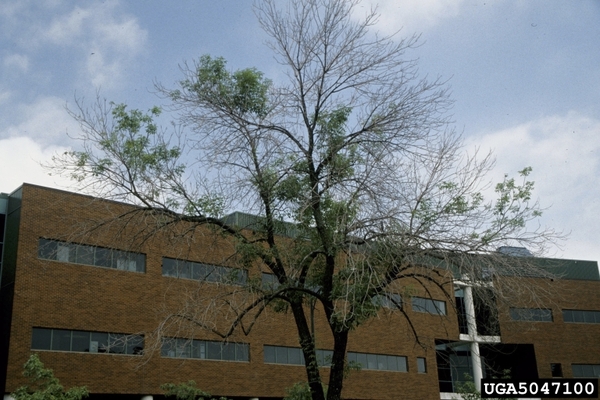Introduction
Anthracnose is a term used to describe a variety of fungal infections affecting hardwood trees. These infections involve many fungal species and host trees. Examples include maple anthracnose, oak anthracnose, and dogwood spot anthracnose. Symptoms can vary and may include leaf lesions (Figure 1), premature leaf drop, cankers, and twig dieback. While most anthracnose infections are cosmetic, severe infection can lead to defoliation (Figure 3) as well as disfigured twigs and branches. The anthracnose infections discussed in this factsheet should not be confused with dogwood anthracnose, which is a serious disease caused by a non-native fungal pathogen that can kill flowering dogwood trees (Benthamidia florida).
Causal Agents and Host Plants
Hosts include many hardwoods such as oak (Quercus spp.), dogwood (Benthamidia spp.), maple (Acer spp.), sycamore (Platanus spp.), ash (Fraxinus spp.), tulip poplar (Liriodendron tulipifera), and walnut (Juglans spp.). Fungi causing anthracnose infection include Gnomonia spp., Discula spp., Kabatiella spp., Apiognomonia spp., and Gloeosporium spp.
Disease Cycle and Damage
Anthracnose often occurs in spring and early summer, especially during periods of cool, wet weather. Fungi produce and release spores, which are structures dispersed by wind or rain that cause new infection. When wet conditions occur, these spores germinate, allowing the fungi to infect new host tissues like leaves or shoots. If favorable conditions continue into the summer, the fungi may produce more spores, but this typically does not occur after mid-summer. These fungal pathogens often overwinter on the ground in dead leaves. However, in some hosts like sycamore, the fungi can overwinter in twigs. The next spring, fungi will release spores from the dead tissue, starting the cycle over again.
On most hosts, anthracnose infects leaves. Leaf lesions form and spread as fungi infect the leaf tissue and extract nutrients from it. Still, anthracnose may infect the twigs and buds of sycamore trees, causing damage to these structures as well.
Signs and Symptoms
he symptoms of anthracnose vary based on environmental conditions, host species, and severity of infection. Still, the most conspicuous symptom of anthracnose is the presence of leaf lesions, which are areas of dead leaf tissue (Fig. 1). Leaf lesions often occur following infection in the spring. These dead spots are typically brown, black, tan, purple, or yellow. Often, lesions appear along leaf veins where water/moisture persists after rainfall, especially on hosts like sycamore, oak, and maple. From there, the lesions may expand outward and coalesce, sometimes killing the entire leaf. Young leaves often appear distorted following infection. Further, severe infection may lead to leaves appearing scorched or damaged by frost. However, leaf scorch causes browning of leaves that starts on the margins and moves inward, whereas anthracnose begins at the leaf veins and spreads outward.
On hosts like sycamore, anthracnose may infect twigs in addition to leaves (Fig. 2). Anthracnose fungi are able to overwinter in buds or twigs before infecting new tissue on these hosts in spring. In these cases, symptoms such as cankers and dieback can occur. Cankers can girdle the twigs, and twigs may become deformed. Additionally, buds and shoots may die. In some hosts, including sycamore, the disease may also cause trees to drop their leaves early (Fig. 3). Still, these trees usually recover and produce more leaves by mid-summer.
Management
Anthracnose does not typically cause serious damage to its hosts, so management is often unnecessary. Nevertheless, proper tree care and sanitation practices can reduce anthracnose infection. Since anthracnose overwinters in leaves and twigs, raking leaves and pruning infected twigs in the fall can greatly reduce spread the following spring. These leaves and twigs should be destroyed. Further, providing adequate space for air circulation and sunlight can help dry host material following wet weather, thereby reducing fungal infection. This can be achieved by spacing trees when planting, thinning/pruning tree canopies, and clearing vegetation around the host trees. Maintaining overall tree health through practices like fertilizing, watering, and mulching can ensure trees do not become stressed. For high-value trees or severe cases, fungicides may be used.
References
Blaedow, R., Heath, B., Langston, W., Lawing, C., Moan, J., Trickel, R., & Oten, K. (2013). Forest Health Handbook (3rd ed.). North Carolina Forest Service.
Berry, F.H. (1985, December). Forest insect and disease leaflet 133: Anthracnose diseases of eastern hardwoods. U.S. Department of Agriculture Forest Service.
Douglas, S. M. (2011, June). Anthracnose diseases of trees. The Connecticut Agricultural Experiment Station.
Downer, A. J., Swain, S. V., & Crump, A. (2020, May). UC IPM pest notes: Anthracnose (No. 7420). University of California Agriculture and Natural Resources.
Publication date: July 13, 2022
N.C. Cooperative Extension prohibits discrimination and harassment regardless of age, color, disability, family and marital status, gender identity, national origin, political beliefs, race, religion, sex (including pregnancy), sexual orientation and veteran status.



